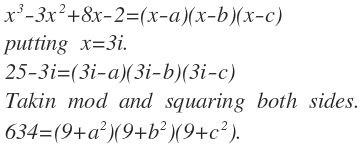Archit's Challenge 2
Given that a , b and c are roots to the equation x 3 − 3 x 2 + 8 x − 2 = 0 , find the value of ( 9 + a 2 ) ( 9 + b 2 ) ( 9 + c 2 ) .
The answer is 634.
This section requires Javascript.
You are seeing this because something didn't load right. We suggest you, (a) try
refreshing the page, (b) enabling javascript if it is disabled on your browser and,
finally, (c)
loading the
non-javascript version of this page
. We're sorry about the hassle.
3 solutions

Wow! Very unusual approach! Thanks for sharing!
i multiplied f(3i) with f(-3i)
nice approach.
challenge 4 is that question is question which you gave me first time
Nice way!!
Archit, you have already assumed that all the three roots of the given polynomial are real. ( As in the 3 r d step, while taking modulus, you have treated a , b and c as real parts. ). But, this is not possible as at least one root has to be complex. How can you justify the 3 r d step ? Rectify me if I'm wrong.
Log in to reply
This works because the modulus operator has been used in the following sense:
∣ f ( x ) ∣ = f ( i x ) . f ( − i x )
Log in to reply
I got it. But, as far as I know, for x ∈ C , ∣ x ∣ is defined as ( ℜ ( x ) ) 2 + ( ℑ ( x ) ) 2 .
Log in to reply
@Aditya Sky – It is. I am just saying the operation he has performed (and called as modulus) is the former.
Unusual indeed. I did a much longer method
I used a much longer approach.
( 9 + a 2 ) ( 9 + b 2 ) ( 9 + c 2 ) 7 2 9 + 8 1 ( a 2 + b 2 + c 2 ) + 9 ( ( a b ) 2 + ( b c ) 2 + ( c a ) 2 ) + ( a b c ) 2 Now using Newton’s Sum and Vieta’s formulae will give us: 7 2 9 + 8 1 ( − 7 ) + 9 ( 5 2 ) + 4 = 6 3 4
Thanks for posting your method.
As a 2 + 9 , b 2 + 9 and c 2 + 9 are symmetric functions of the roots of the given polynomial, so we can transform the given polynomial into a polynomial whose roots are of the form a 2 + 9 . The required value would then be equal to the product of roots of that polynomial which can be determined using Viete. The transfromed polynomial is x 3 − 2 0 x 2 + 1 6 9 x − 6 3 4 . Using this polynomial, we can also figure out the value of expressions like :- 1 . ) ( a 2 + 9 ) + ( b 2 + 9 ) + ( c 2 + 9 ) 2 . ) ( a 2 + 9 ) ( b 2 + 9 ) + ( b 2 + 9 ) ( c 2 + 9 ) + ( c 2 + 9 ) ( a 2 + 9 )